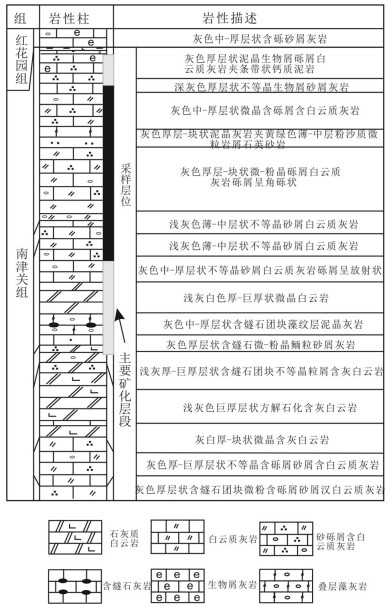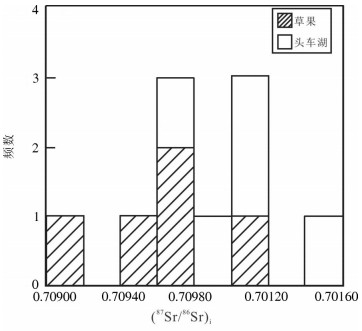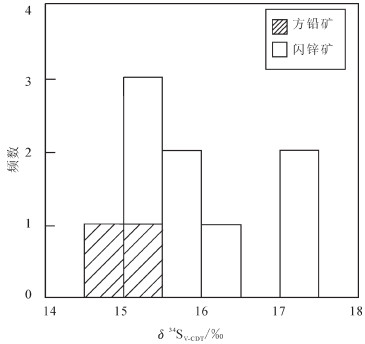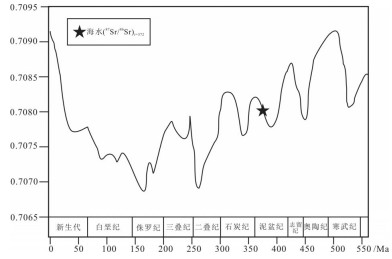Strontium and sulfur isotopic characteristics of the Tangjiazhai Pb-Zn deposit in western Hunan Province, China: Denotative significance for ore-forming materials Source
-
摘要:
唐家寨铅锌矿床位于湘西龙山—洛塔铅锌矿区的中部。对闪锌矿开展了锶同位素测试分析,通过成矿年龄(372Ma)的校正,得到初始(87Sr/86Sr)i的范围为0.70904~0.71143,平均值为0.70998(n=10),大于矿床形成时的海水Sr同位素,远小于富含有机质的下寒武统石牌组页岩层的Sr同位素,推测成矿流体中的Sr,可能是由具有较低Sr同位素组成的成矿期的海水混染了具有高Sr同位素的下寒武统石牌组页岩层而致。9件闪锌矿和方铅矿样品的δ34SV-CDT值介于14.78‰~17.21‰,平均值为15.84‰,比同期(早奥陶世)海相硫酸盐硫同位素组成的平均值(29.5‰)低13.66‰,符合该矿床成矿温度(100~200℃)条件下硫同位素的分馏效应(10‰~20‰),表明硫化物中还原硫可能主要来源于赋矿地层中海相硫酸盐的热化学还原作用(TSR)。
Abstract:The Tangjiazhai Pb-Zn deposit is located in the middle of the Longshan-Luota mining field in western Hunan Province, China, and is an important lead and zinc reserve base for Hunan Province. Sr isotope compositions measured for sphalerite were agecorrected by 372 Ma. As a result, the (87Sr/86Sr)i values range from 0.70904 to 0.71143 with an average value of 0.70998(n=10) which is higher than that of the seawaterin the mineralized age (372 Ma), and lower than that of Lower Cambrian Shipai Formation shale enriched in organic matter. Speculation can be made is that Sr in ore-forming fluids is sourced from seawater (372 Ma) with relatively lower Sr contaminated high Sr Lower Cambrian Shipai Formation shale. Sphalerite and galena are measured for sulfur isotope composition. The δ34SV-CDT values of them have a range from 14.78‰ to 7.21‰ with a mean of 15.84‰ (n=9) which is lower 13.66‰ than that of the Early Ordovician seawater sulfate. This variation conforms to sulfur isotope fractionation of 10‰-20‰ when the mineralized temperature is from 100℃ to 200℃.These evidences indicate that the reduced sulfur in the sulfides probably derive from the Thermochemical Sulfate Reduction (TSR) of seawater sulfate within the ore-bearing strata.
-

-
图 1 湘西地区铅锌矿床区域构造简图(据杨绍祥等, 2007b修改)
Figure 1.
表 2 唐家寨矿床块状铅锌矿石中硫化物硫同位素组成
Table 2. S isotope compositions of the sulfides from the massive Pb-Zn ores in Tangjiazhai Pb-Zn deposit
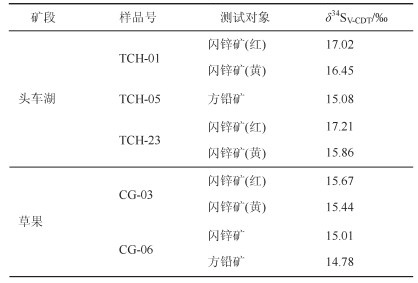
表 1 唐家寨矿床块状铅锌矿石中闪锌矿Rb、Sr同位素数据
Table 1. Data of Rb and Sr isotopes of the sphalerite from the massive Pb-Zn ores in Tangjiazhai Pb-Zn deposit
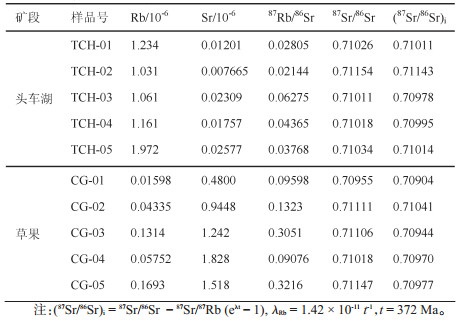
-
Bao Juemin, Zhang Anyuan. 1989. Preliminary study on the sedimentary facies of the Longshan Pb-Zn mineralized zone in northwestern Hunan and its mineralization[J]. Journal of Guilin College of Geology, 9(4):309-410 (in Chinese with English abstract). http://en.cnki.com.cn/Article_en/CJFDTotal-GLGX198904008.htm
Cai Chunfang, Li Hongtao. 2005. Thermochemical sulfate reduction in sedimentary basins:a review[J]. Advances in Earth Science, 20(10):1100-1105(in Chinese with English abstract). http://cn.bing.com/academic/profile?id=0c1e9818dc79dc1c5b18bc9675c07a38&encoded=0&v=paper_preview&mkt=zh-cn
Cai Yingxiong, Yang Hongmei, Duan Ruichun, Lu Shansong Zhang Liguo, Liu Chongpeng, Qiu Xiaofei. 2014. Fluid inclusions and S, Pb, C isotope geochemistry of Pb-Zn deposits hosted by Lower Cambrian in western Hunan-eastern Guizhou area[J]. Geoscience, 28(1):29-41 (in Chinese with English abstract) http://cn.bing.com/academic/profile?id=174263d6a76543b3490ac23b409558cc&encoded=0&v=paper_preview&mkt=zh-cn
Chen Fenning, Ji Wenhua, Zhang Haijun, Chen Shoujian, Gu Pingyang, Du Bingying. 2016. The discovery of conodonts fossils and the strontium isotope composition of Labuchari Formation in Tanggula Range and and their stratigraphic significance[J]. Geology in China, 43(4):1139-1148(in Chinese with English abstract). https://ar.scribd.com/document/337186531/substancial
Claypool G E, Holser W T, Kaplan I R, Sakai H, Zak I. 1980. The age curves of sulfur and oxygen isotopes in marine sulfate and their mutual interpretation[J]. Chemical Geology, 28:199-260. doi: 10.1016/0009-2541(80)90047-9 http://cn.bing.com/academic/profile?id=394aef848766d782d77bcf923fe729e8&encoded=0&v=paper_preview&mkt=zh-cn
Dixon G, Davidson G J. 1996. Stable isotope evidence for thermochemical sulfate reduction in the Dugald river (Australia) strata-bound shale-hosted zinc-lead deposit[J]. Chemical Geology, 129(3):227-246. https://www.deepdyve.com/lp/elsevier/stable-isotope-evidence-for-thermochemical-sulfate-reduction-in-the-Cx3gATE0q5
Du Guomin, Cai Hong, Mei Yuping. 2012. Application of Rb-Sr isochron dating method in sphalerite of sulfide deposit-A case study from Dagoudong Pb-Zn deposit in Xinhuang Western Hunan Province[J]. Geology and Mineral Resources of South China, 28(2):175-180(in Chinese witn English abstract). http://www.wanfangdata.com.cn/details/detail.do?_type=perio&id=hndzykc201202011
Du Yudiao, Liu Jiajun, Yu Xinqi, Zhou Xiang, Yang Heming, Yang Longbo. 2013. The sources of metallogenic materials and mineralization of the Xiaoyao W-polymetallic deposit in Anhui Province:Evidence from carbon. Sulfur and lead isotopes[J]. Geology in China, 40(2):566-579 (in Chinese with English abstract). http://en.cnki.com.cn/Article_en/CJFDTOTAL-DIZI201302021.htm
Duan Qifa, Cao Liang, Zeng Jiankang, Zhou Yun, Tang Chaoyang, Li Kun. 2014. Rb-Sr dating of sphalerites from Shizishan Pb-Zn deposit in Huayuan ore concentration area, western Hunan and its geological significance[J]. Erath Science——Journal of China University of Geosciences, 39(8):977-986+999 (in Chinese with English abstract). doi: 10.3799/dqkx.2014.089 http://en.cnki.com.cn/Article_en/CJFDTotal-DQKX201408004.htm
Kuang Wenlong, Liu Xinhua, Chen Niansheng, Yu Peiran, Chen Xinyue. 2008. Main geochemical characteristics of lead-zinc deposits in Xiaguangrong ore district, northwestern Hunan[J]. Chinese Journal of Geology, 43(4):685-694(in Chinese with English abstract). https://www.researchgate.net/publication/290538513_Main_geochemical_characteristics_of_lead-zinc_deposits_in_Xiaguangrong_ore_district_northwestern_Hunan
Kuang Wenlong, Xiang Shichao, Xiao Wenzhou, Chen Wei, Yang Shaoxiang, Yu Peiran, Chen Niansheng. 2015. Metallogenic geological characteristics and genesis of lead-zinc deposit in northwestern Hunan[J]. Mineral Deposits, 34(5):1072-1082(in Chinese with English abstract). http://en.cnki.com.cn/Article_en/CJFDTotal-KCDZ201505014.htm
Li Kun, Wu Changxiong, Tang Chaoyang, Duan Qifa, Yu Yushuai. 2014. Carbon and oxygen isotopes of Pb-Zn ore deposits in western Hunan and eastern Guizhou Provinces and their implications for the ore-forming process[J]. Geology in China, 41(5):1608-1619(in Chinese with English abstract). http://cn.bing.com/academic/profile?id=b3240926d2750dc01e9fdf3dbb52baa7&encoded=0&v=paper_preview&mkt=zh-cn
Liang Xinquan, Guo Dingliang. 2002. Deep tectonic activation and its shallow response in Hunan Province[J]. Chinese Journal of Geology, 37(3):332-342(in Chinese with English abstract). http://en.cnki.com.cn/Article_en/CJFDTotal-SCDB200504007.htm
Liu Jinsong, Zou Xianwu, Tang Chaoyang, Cui Sen, Xia Jie, Zhao Wuqiang. 2015. Geological characteristics of Pb-Zn deposit and prospecting directions in Songtao, Guizhou Province and Jiwei, Hunan Province[J]. Geology and Exploration, 51(4):634-645(in Chinese with English abstract). http://en.cnki.com.cn/Article_en/CJFDTOTAL-DZKT201504004.htm
Liu Xuelong, Li Wenchang, Zhang Na, Yang Fucheng, Kang Jian, Zhang Biao. 2016. Characteristics of sulfur and lead Isotopes and tracing of mineral sources in the Tongchanggou porphyry Mo(Cu)deposit at the southern edge of Geza arc belt, Yunnan[J]. Geology in China, 43(1):209-220(in China with English abstract). http://www.en.cnki.com.cn/Article_en/CJFDTotal-DIZI201601015.htm
Machel H G, Krouse H R, Sassen R. 1995. Products and distinguishing criteria of bacterial and thermochemical sulfate reduction[J]. Applied Geochemistry, 10(4):373-389. doi: 10.1016/0883-2927(95)00008-8 http://cn.bing.com/academic/profile?id=3a64d29c0f00bc4e9435ec6d7f534263&encoded=0&v=paper_preview&mkt=zh-cn
Machel H. 2001. Bacterial and thermochemical sulfate reduction in diagenetic settings-old and new insights[J]. Sedimentary Geology, 140(1):143-175. http://cn.bing.com/academic/profile?id=10cd21fa4d16b2cb238e35ada8a6e460&encoded=0&v=paper_preview&mkt=zh-cn
McArthur J M, Burnett J, Hancock J M. 1992. Strontium isotopes at K/T boundary:discussion[J]. Nature, 355(6355):28. doi: 10.1038/355028a0
McArthur J M, Howarth R J, Shields, G A. 2012. Strontium isotope stratigraphy[J].The Geological Time Scale, 127-144. http://cn.bing.com/academic/profile?id=524cec33bbce9701713a15ad5912f8ff&encoded=0&v=paper_preview&mkt=zh-cn
Ohmoto H, Kaiser C J, Geer K A. 1990. Systematics of sulphur isotopes in recent marine sediments and ancient sediment-hosted basemetal deposits[C]//Herbert H R, Ho S E(eds. ). Stable Isotopes and fluid processes in Mineralization, 23: 70-120.
Ohmoto H, Rye R. 1979. Isotopes of sulfur and carbon[C]//Geochemistry of Hydrothermal Ore Deposits, 509-567.
Schneider J, Boni M, Lapponi F, Bechstädt, T. 2002. Carbonatehosted zinc-lead deposits in the Lower Cambrian of Hunan, South China:a radiogenic (Pb, Sr) isotope study[J]. Economic Geology, 97:1815-1827. doi: 10.2113/gsecongeo.97.8.1815 https://www.researchgate.net/publication/270456772_Carbonate-Hosted_Zinc-Lead_Deposits_in_the_Lower_Cambrian_of_Hunan_South_China_A_Radiogenic_Pb_Sr_Isotope_Study
Team 405 of bureau of geology and mineral resources of Hunan province. 1988. Metallogenic Regularity and its Prediction of Yutang Orefield in Huayuan County Hunan Province[M]. Beijing:Geological Publishing House, 1-1100(in Chinese).
Wang Xilong, Liu Jiajun, Zhai Degao, Wang Jianping, Zhang Qibin, Zhang Anli. 2014. A study of isotope geochemistry and sources of ore-forming materials of the Bianjiadayuan silver polymetallic deposit in Linxi, Inner Mongolia[J]. Geology in China, 41(4):1288-1303(in Chinese with English abstract). http://en.cnki.com.cn/Article_en/CJFDTOTAL-DIZI201404020.htm
Wang Yunfeng, Yang Hongmei. 2016. Sulfur isotope tracing of oreforming hydrothermal fluid for metallic sulfide deposit[J]. Advances in Earth Science, 31(6):595-602 (in Chinese with English abstract). https://www.researchgate.net/publication/283380720_Sulfur-lead-oxygen_isotope_compositions_of_the_huanggang_skarn_Fe-Sn_deposit_Inner_Mongolia_Implications_for_the_sources_of_ore-forming_materials
Wang Yunfeng, Yang Hongmei, Qiu Xiaofei, Lu Shansong, Cai Yingxiong. 2016. Ore-forming materials sources of the Shizishan Pb-Zn deposit in western Hunan Province, China[J]. Acta Geological Sinica (English Edition), 90(5):1929-1930. doi: 10.1111/acgs.2016.90.issue-5 http://kns.cnki.net/KCMS/detail/detail.aspx?filename=dzxw201605038&dbname=CJFD&dbcode=CJFQ
Wen Kedong, Li Guozhen, Liu Haotian. 2011. Analysis on Shale Gasforming condition of Lower Cambrian in middle Yangtze Block[J]. Petroleum Technology of Jianghan, 21(3):1-5(in Chinese).
Wu Genyao. 2002. The Yanshanian orogeny and late Mesozoic activation in China continent[J]. Chinese Journal of Geology, 37(4):453-461(in Chinese with English abstract). http://en.cnki.com.cn/Article_en/CJFDTOTAL-DZKX200204008.htm
Yang Shaoxiang, Lao Ketong. 2007a. A tentative discussion on genesis of lead-zinc deposits in northwest Hunan[J]. Mineral Deposits, 26(3):330-340(in Chinese with English abstract). http://cn.bing.com/academic/profile?id=b9bf2150c416b420c4eef9b0312f6431&encoded=0&v=paper_preview&mkt=zh-cn
Yang Shaoxiang, Lao Ketong. 2007b. Geological characteristics and ore indicators of lead-zinc deposits in northwestern Hunan, China[J]. Geological Bulletin of China, 26(7):899-908(in Chinese with English abstract). http://cn.bing.com/academic/profile?id=d61a932d9feb622637a1d7bd92f6718a&encoded=0&v=paper_preview&mkt=zh-cn
Yang Shaoxiang, Yu Peiran, Lao Ketong. 2006. Pb-Zn deposits metallogenic regularity and prospecting direction in northwestern of Hunan, China[J]. Land and Resources Herald, 92-98(in Chinese).
Zheng Yongfei, Chen Jiangfeng. 2000. Stable Isotope Geochemistry[M]. Beijing:Science Press, 1-468.
Zhou Yun, Duan Qifa, Chen Yuchuan, Tang Juxing, Cao Liang, Gan Jinmu. 2015. Rb-Sr dating and tracer study of quartz from the Jiangjiaya lead-zinc deposit in western Hunan[J]. Geology in China, 42(2):597-606(in Chinese with English abstract). http://cn.bing.com/academic/profile?id=903d42cf1f33140211e78ac1a7c9ec14&encoded=0&v=paper_preview&mkt=zh-cn
鲍珏敏, 张安源. 1989.湘西北龙山铅锌矿带沉积相及成矿作用[J].桂林冶金地质学院学报, 9(4):309-410. http://www.cnki.com.cn/Article/CJFDTotal-ZGYR1988S1013.htm
蔡春芳, 李宏涛. 2005.沉积盆地热化学硫酸盐还原作用评述[J].地球科学进展, 20(10):1100-1105. doi: 10.3321/j.issn:1001-8166.2005.10.009
蔡应雄, 杨红梅, 段瑞春, 卢山松, 张利国, 刘重芃, 邱啸飞. 2014.湘西-黔东下寒武统铅锌矿床流体包裹体和硫, 铅, 碳同位素地球化学特征[J].现代地质, 28(1):29-41. http://www.wanfangdata.com.cn/details/detail.do?_type=perio&id=xddz201401003
陈奋宁, 计文化, 张海军, 陈守建, 辜平阳, 杜兵盈. 2016.唐古拉地区拉卜查日组牙形石的发现、锶同位素组成及地层学意义[J].中国地质, 43(4):1139-1148. http://geochina.cgs.gov.cn/ch/reader/view_abstract.aspx?file_no=20160402&flag=1
杜国民, 蔡红, 梅玉萍. 2012.硫化物矿床中闪锌矿Rb-Sr等时线定年方法研究[J].华南地质与矿产, 28(2):175-180. http://www.wanfangdata.com.cn/details/detail.do?_type=perio&id=hndzykc201202011
杜玉雕, 刘家军, 余心起, 周翔, 杨赫鸣, 杨隆勃. 2013.安徽逍遥钨多金属矿床成矿物质来源与找矿:碳、硫、铅同位素证据[J].中国地质, 40(2):566-579. http://geochina.cgs.gov.cn/ch/reader/view_abstract.aspx?file_no=20130220&flag=1
段其发, 曹亮, 曾健康, 周云, 汤朝阳, 李堃. 2014.湘西花垣矿集区狮子山铅锌矿床闪锌矿Rb-Sr定年及地质意义[J].地球科学——中国地质大学学报, 39(8):977-986, 999. https://www.wenkuxiazai.com/doc/fa733fd90b4c2e3f5627635e-2.html
湖南省地质矿产局. 1988.湖南省区域地质志[M].北京:地质出版社, 1-1100.
匡文龙, 刘新华, 陈年生, 余沛然, 陈新跃. 2008.湘西北下光荣矿区铅锌矿床主要地球化学特征[J].地质科学, 43(4):685-694. http://www.cqvip.com/QK/94066X/200804/28586244.html
匡文龙, 向世超, 肖文舟, 陈伟, 杨绍祥, 余沛然, 陈年生. 2015.湘西北地区铅锌矿床成矿地质特征及矿床成因研究[J].矿床地质, 34(5):1072-1082. http://industry.wanfangdata.com.cn/yj/Detail/Periodical?id=Periodical_kcdz201505014
李堃, 吴昌雄, 汤朝阳, 段其发, 于玉帅. 2014.湘西黔东地区铅锌矿床C、O同位素地球化学特征及其对成矿过程的指示[J].中国地质, 41(5):1608-1619. http://geochina.cgs.gov.cn/ch/reader/view_abstract.aspx?file_no=20140516&flag=1
梁新权, 郭定良. 2002.湖南深部构造活化及其浅部响应[J].地质科学, 37(3):332-342. http://www.wanfangdata.com.cn/details/detail.do?_type=perio&id=dzkx200203009
刘劲松, 邹先武, 汤朝阳, 崔森, 夏杰, 赵武强. 2015.贵州松桃-湖南吉卫地区铅锌矿地质特征及找矿方向[J].地质与勘探, 51(4):634-645. http://www.cqvip.com/QK/93079X/201504/666978607.html
刘学龙, 李文昌, 张娜, 杨富成, 康建, 张彪. 2016.云南格咱岛弧带南缘铜厂沟斑岩型铜钼矿床硫铅同位素特征与成矿物质来源示踪[J].中国地质, 43(1):209-220. doi: 10.12029/gc20160115 http://geochina.cgs.gov.cn/ch/reader/view_abstract.aspx?file_no=20160115&flag=1
王喜龙, 刘家军, 翟德高, 王建平, 张琪彬, 张安立. 2014.内蒙古林西边家大院银多金属矿床同位素地球化学特征及成矿物质来源探讨[J].中国地质, 41(4):1288-1303. http://geochina.cgs.gov.cn/ch/reader/view_abstract.aspx?file_no=20140420&flag=1
王云峰, 杨红梅. 2016.金属硫化物矿床的成矿热液硫同位素示踪[J].地球科学进展, 31(6):595-602 http://www.cnki.com.cn/Article/CJFDTOTAL-DXJZ201606008.htm
文可东, 李国珍, 刘皓天. 2011.中扬子区下寒武统页岩气形成条件分析[J].江汉石油科技, 21(3):1-5. http://mall.cnki.net/magazine/Article/JHSK201103004.htm
吴根耀. 2002.燕山运动和中国大陆晚中生代的活化[J].地质科学, 37(4):453-461. http://www.wanfangdata.com.cn/details/detail.do?_type=perio&id=dzkx200204009
杨绍祥, 劳可通. 2007a.湘西北铅锌矿床碳氢氧同位素特征及成矿环境分析[J].矿床地质, 26(3):330-340. http://www.doc88.com/p-174613791697.html
杨绍祥, 劳可通. 2007b.湘西北铅锌矿床的地质特征及找矿标志[J].地质通报, 26(7):899-908. http://www.oalib.com/paper/4898191
杨绍祥, 余沛然, 劳可通. 2006.湘西北地区铅锌矿床成矿规律及找矿方向[J].国土资源导刊, 3, 92-98. doi: 10.3969/j.issn.1672-5603.2006.03.025 http://kns.cnki.net/KCMS/detail/detail.aspx?filename=gtdk200603025&dbname=CJFD&dbcode=CJFQ
郑永飞, 陈江峰. 2000.稳定同位素地球化学[M].北京:科学出版社, 1-468.
周云, 段其发, 陈毓川, 唐菊兴, 曹亮, 甘金木. 2015.湘西龙山江家垭铅锌矿床石英Rb-Sr同位素测年与示踪研究[J].中国地质, 42(2):597-605. http://geochina.cgs.gov.cn/ch/reader/view_abstract.aspx?file_no=20150218&flag=1
-



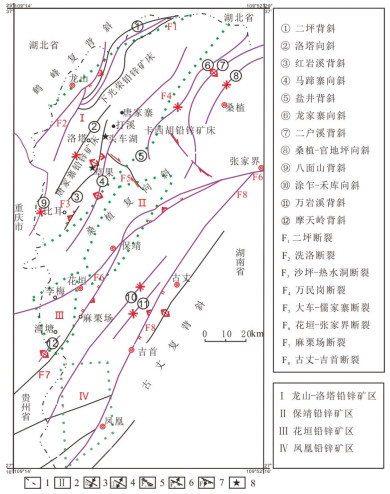
 下载:
下载:
